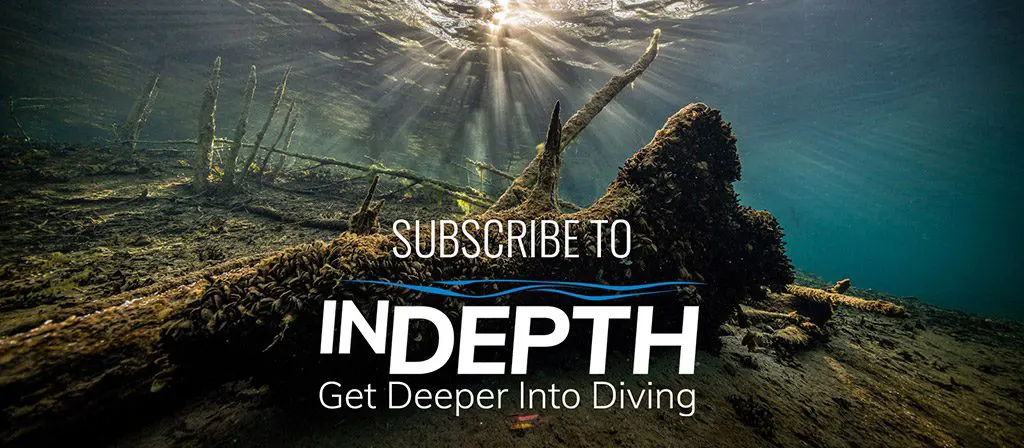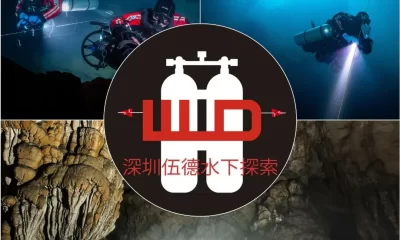Equipment
Omne Trium Perfectum
Good things come in threes. At least that’s what explorer and former commercial diver Axel Schoeller believed when he needed a specialized rebreather platform for a deep open water project. The result of several years’ effort is a triple closed-circuit rebreather configuration—one back mount with two sidemount CCRs— that Schoeller dubbed his “CCR Trilogy.” The author explains his DIY motivations, how he went about constructing the rig, and a little about his dives.
Text and Images by Axel Schoeller unless noted.
🎶 Pre-dive clicklist: Il barbiere di Siviglia by Gioachino Rossini🎶
1 JUNE, 2023—We are greatly saddened to report that the 60-year old author, Axel Schoeller died on a 100-meter solo rebreather dive on his CCR Trilogy rig near Protaras, Cyprus, less than a day after we published his story. We are awaiting details. RIP Axel. According to DAN, which verified Axel’s death, he is the third rebreather diver to die in the last seven days.
The phrase, “Omne Trium Perfectum” (Three is perfection), conceived of by Confucius in 500 B.C.E. and later translated to Latin, definitely applies to the concept of a triple closed-circuit rebreather (CCR) or “CCR Trilogy.” If you google “CCR Trilogy” you may end up with a baby carriage, which besides being used for NASA applications, isn’t helpful for the purpose of this article. Although of course, astronauts use rebreathers during their extra vehicular activities (EVAs).
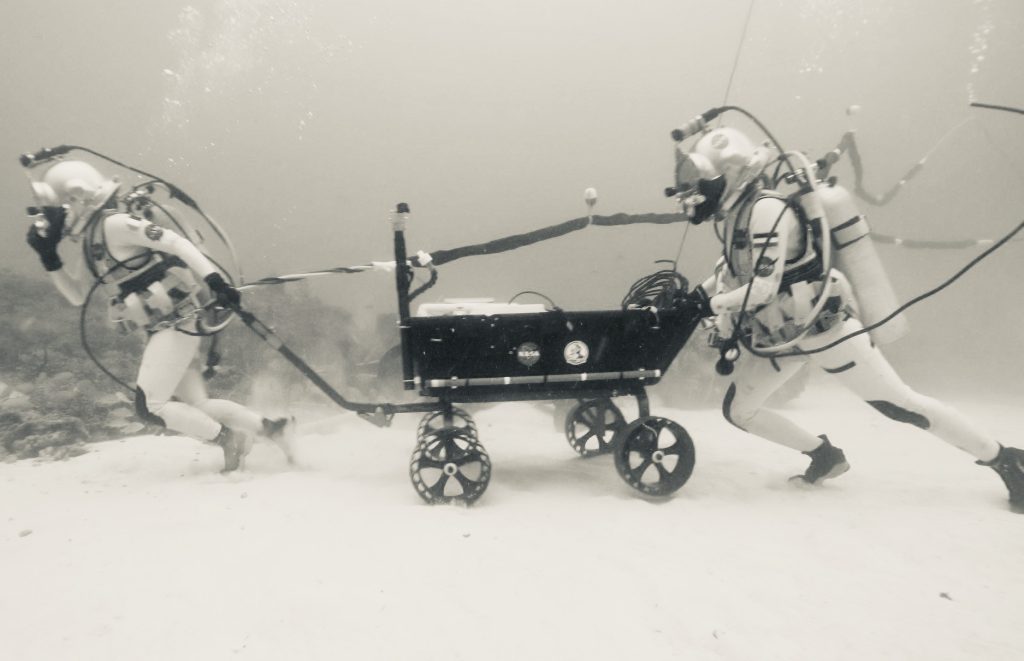
OpenAI’s language model GTP-4 does a bit better and suggests that groups of three are inherently satisfying and harmonious. I can live with a rebreather configuration like that.
Planting a Seed
Once upon a time, a rather challenging open ocean scientific dive project appeared on my to-do list and demanded a custom-built dive system to get to the job and back, with a sufficient bailout arrangement and efficient parameters for working dives. The task was to collect unique bottom samples and record data at depths beyond the air diving range at specified locations in Cyprus, and slowly increase the range in small increments and steps if feasible. This is in cooperation with Cyprus government, university and commercial academia in marine biology and geology. As a safety factor, I wanted to eliminate time constraints. In order not to add this layer of stress. During a recent visit to Cyprus, cave explorer Jim Bowden, a team mate of the late Sheck Exley) explained to me that working under time restrictions creates dangerous risks. The “no time limit” also gave me ample opportunity to gradually field test the CCR Trilogy.

As always, it starts with a maybe crazy idea which has somewhere an atom of possibility attached to it. Latter is the driving force, for I was able to persuade a small team of mad divers to follow my cult. “Think big” was the necessary agenda and, in order to maximize dive range, we started to build a bailout system around a CCR. Scuba Tech Diving Center in Cyprus, is the number one goto place for CCR diving on the island and my primary source for technical advice and implemetation during the building phase of the CCR Trilogy.
Searching through our workshops of what we had flying about, we took a Megalodon CCR and wedged it between two 20-litre tanks and started to play the configuration. Then we added another two 20-litre tanks as wing tanks plus two five litres for independent inflation. Our limit was defined by what the diver could carry—no extra staging and self-reliant solo diving. Although my CCR Trilogy concept is built for such diving I do on occasion have support divers for in-water checks and for monitoring and stand-by during the return in the upper deco levels.
Editor’s note: Global Underwater Explorers does not sanction solo diving. Furthermore, solo CCR diving was recently addressed by Rebreather Forum 4 in a consensus statement which reads, “The forum recognizes that solo diving may increase the likelihood of a fatality in the event of a rebreather diving incident.”
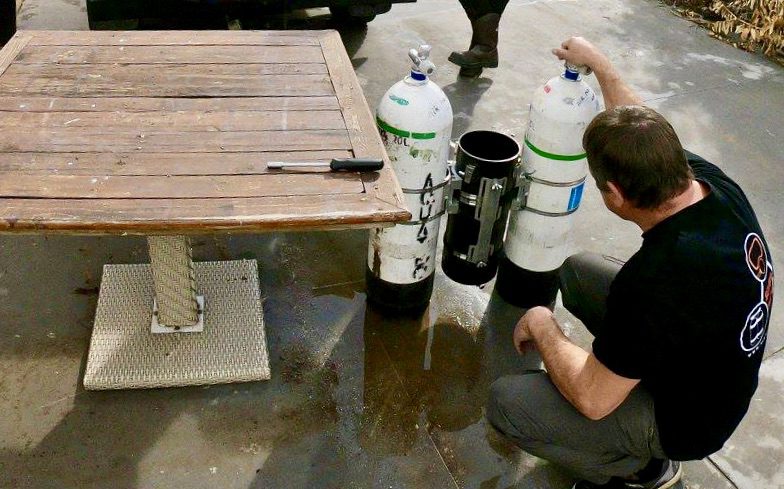
The next challenge was to incorporate a Draeger Nova full face mask (FFM), so I didn’t have to fumble too much with swapping regs and to minimize clutter. The first solution we came up with was to connect the rebreather and two regs to the mask with custom machined adapters made by TecMe in Germany which delivered a precision job. The gas was ultimately supplied via a switch block on each side mounted at the chest (two gases per block per side). In case of need, four OC gas mixes could then be delivered via two regulators including the supply to the rebreather.

All was great, and it worked—in the water, that was. The nightmare was at the surface—to set up, get dressed, into the water, and then, of course, the reverse with about 150kg+ of equipment strapped to you. It was no fun in a sun-burning climate with average summer temperatures of 35C/95f. Drysuits were needed, of course, for the water temperatures of 15-17C/60-63f.
At times, life got easy, as I was able to convince my commercial dive employer to provide us with a small diver support vessel (DSV) with a crane. We custom built a Launch and Recovery System (LARS) platform out of waterproof pallets and got deployed and hauled in and out of the sea. The fun was short lived as the vessel was commissioned for a proper commercial surface supply dive job, and we had to resort to a RIB. Just to move around in the boat (with the kit on) to enter the water was a project in itself. But we pushed on and made it happen.
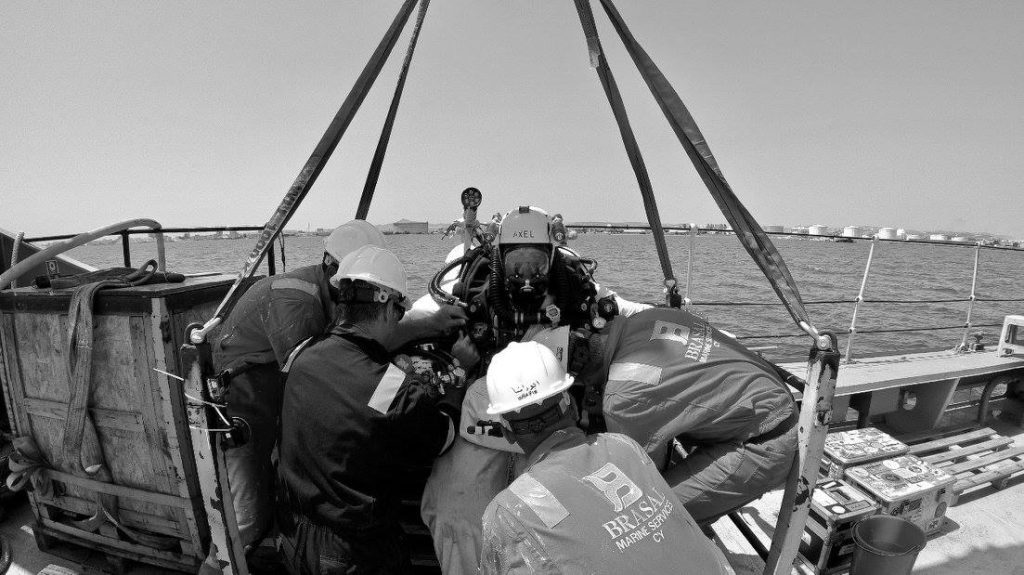
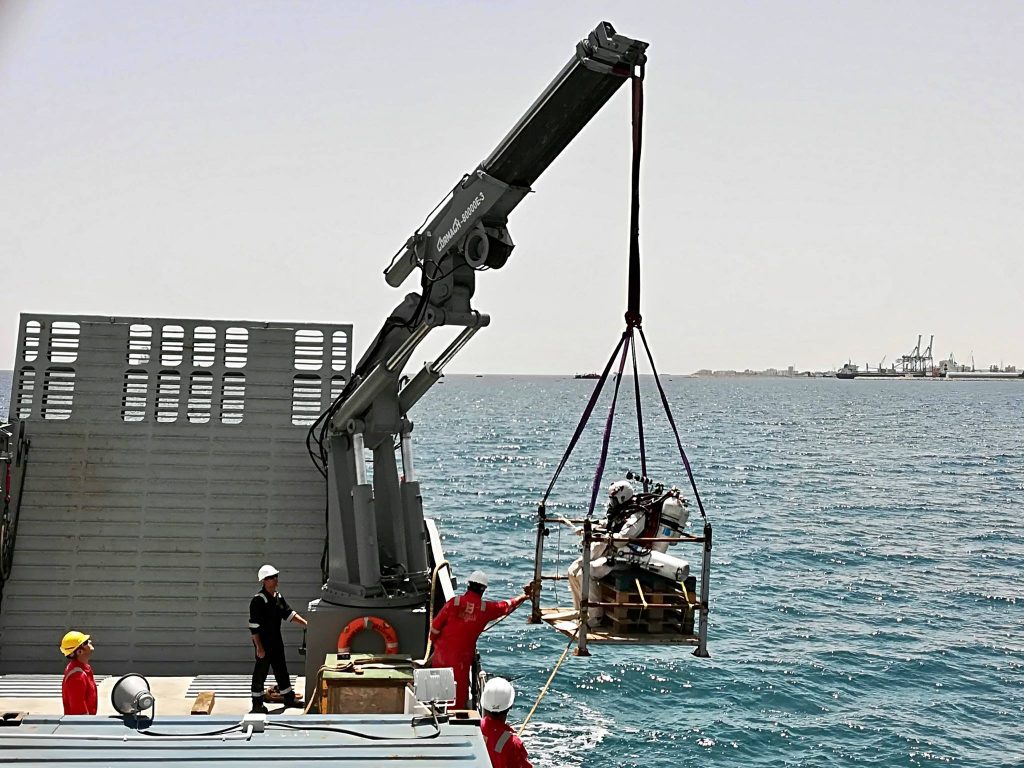
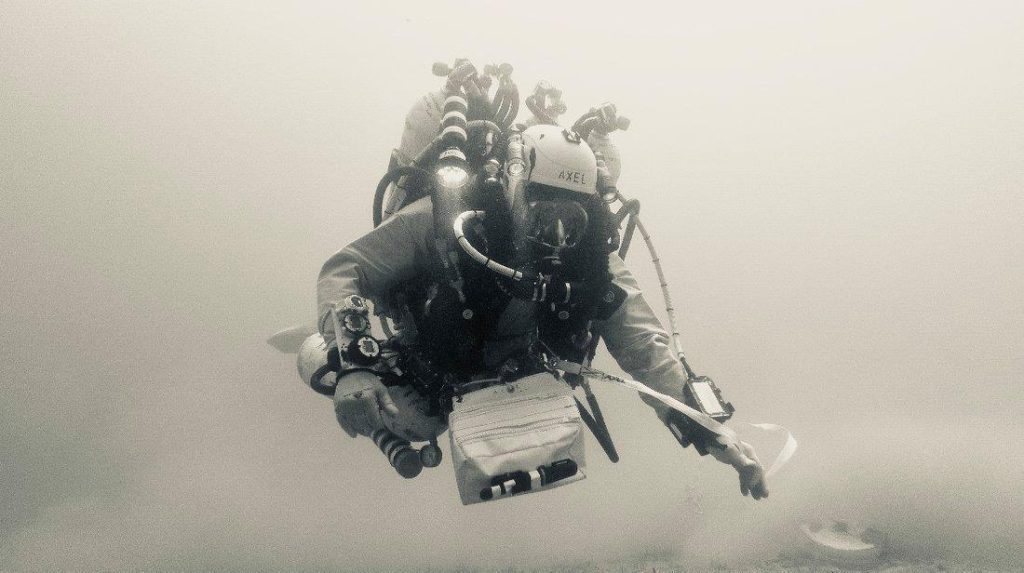
Evolution and Metamorphosis
The SARS-CoV-2 bug interfered, and all dive ops came to a stand-still. The coming periods of quarantine and seclusion gave us ample time to think the monster system over. It became clear that open-circuit was not cutting it: The open circuit system was too bulky, heavy and a logistic nightmare to move around out of the water and to get dressed in and out. Obviously open circuit is also wasteful of gas. So I went back to the drawing board. On top of that, the dive industry started producing sidemount rebreathers.
As in all sectors of diving there is a constant technological upgrade and development process due to demand. Efficiency is king. Rebreathers rule!
The majority of dive apparatus in military applications are rebreathers. Commercial saturation (SAT) diving uses surface supplied reclaim systems and rebreathers as bailouts. As early as the 1980s, Draeger advertised its bailout CCR 450 rated to depths of 600m/1969 ft.
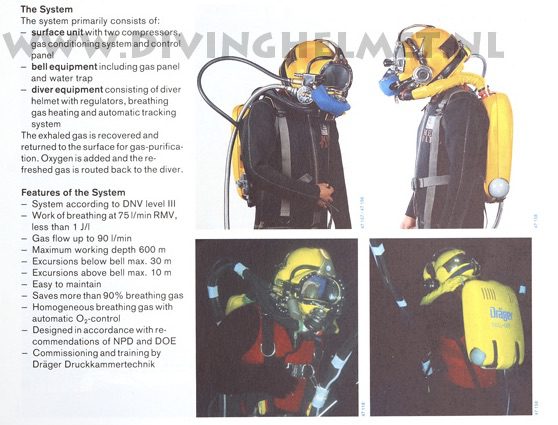
In scientific diving, rebreathers become more of a choice because of their efficiency and economics for increasingly challenging underwater research work. In the world of open circuit (OC) SCUBA, the transition from simple cylinders to twinsets or triplets and then added wing tanks was a natural evolution. Sport CCR will likely go the same way. Dual CCRs are more often seen nowadays. And there are many sidemount units around. Just put them all together and—voila—it’s a CCR Trilogy. If you can carry two OC breathing devices, one on each side, and one on your back—why not CCRs? Of course there are some little disadvantages, but nothing we couldn’t overcome.
OC has its place and won’t go away, but a rebreather gives you much more carry-able breathing time, bailout range, and many other advantages, especially when multiplied by three. In a bailout scenario, I do not want to be overly concerned about limited breathing gas supplies or different gas mixes.
Standardizing on Divesoft
The first thing we did was to ditch the two 20-L cylinders and swap them for sidemount bailout rebreathers. We concluded that a mix of CCR models was messy and not an ideal thing to do. After some good research and deliberation, we chose to go the whole nine yards. Our choice fell on Divesoft in the Czech Republic. As a commercial diver, I was able to pile up some stash and, together with some leftover emeralds from the Atocha, Darwinism took its path. I emptied my Swiss bank account, salvaged some Nazi gold from an U-Boat, plus I donated an arm and a leg for two Liberty Sidemounts, a Liberty heavy backmount, and all the other bits and pieces, plus extras.
Besides the Liberty being an excellent piece of engineering with a lot of redundancy and flood resistance built in, another reason for choosing Divesoft was that it is built in Europe. The latter was an economic advantage, and an added bonus was no red tape when dealing with foreign technology. Quick and economic access to service and parts paired with outstanding customer support. Plus you always get a rubber chicken with your kit. Although I am sure some at Divesoft had to consume an increase in calming medications when dealing with me.
Another nice feature of the Liberty CCRs are the two built-in checklists on the individual handset controllers. The inner components of the heads have a dual redundancy with 2 separate batteries, 4 x O2 sensors, 4 depth sensors, 2 solenoids and as an option 2 HE sensors. If one component fails, it automatically is taken over by the back-up. Both systems compare each other continuously. If the handset or Optical Display Adapter (ODA), a HUD, fails the remaining display will still run on and provide the necessary info to maintain the CCR unit.
Multiple gas mixes and set-points can be pre-programmed for automatic switching at predefined depths including a built-in stand-by bailout-CCR option, which halts the firing of the solenoids when the unit is not in use. Although I try to maintain the same gas mix throughout the CCR Trilogy it sometimes happens that there are differences between the unit gases. No problem for computing or switching CCRs.
Divesoft incorporates the individual bail-out gases for the CCRs in stand-by mode within the software electronics. When switching to another CCR, the different gas mix will automatically be taken over and calculated to maintain the correct dive profile algorithm on all the CCRs.
During controller setup, attention to detail is of the essence. On average, it takes me at least a long day to set up the CCR Trilogy. Checklists rule!
Not Off The Shelf
You don’t buy a CCR Trilogy off the shelf. A CCR Trilogy is formed for a specific task as is evident from the few divers using such a configuration. In this case, a standardised setup as advocated by some dive organizations won’t happen any time soon. A CCR Trilogy is a customized life support system, which needed modifications as well as associated in-water testing. My system was specifically designed for open water environments and NOT cave diving or dives in restrictive spaces.
The SMs took a good deal of time to rig and trim to my liking. The Eastern Mediterranean, our main operation theater, is highly salty, and we had to add weights to the SMs for trim. Also, we chose extended scrubbers which, under the right conditions, can provide 6-8 hours of dive time each according to Divesoft. We cut it at max 6 hours or even after one dive when underwater work demands. I never swap scrubbers or CCR body parts between the units. Regardless of remaining time, the scrubbers stay with the specific unit. On each dive I regularly switch between the three CCRs for performance checks and CCR switch drills and, of course, pay close attention to tracking the three remaining scrubber times.
The backmount (BM) system has the same scrubber and head as the sidemounts (SM). As a remembrance to the original outset, we mounted 2 x 12 litre 300 bar carbon tanks to the back mounted unit with a LOLA valve connection system, similar to Global Underwater Explorers (GUE) configuration. The twin 12s function as diluent for the BM plus as OC switch gas when swapping between the CCRs.
For peace of my mind, I decided to equip both SMs with Bail Out Valves (BOVs) fed by the BM diluent via quick disconnects. That gives me OC switch gas at any time no matter which CCR I am on (during writing this article, IQSub came out with a new specialized BOV for SM rebreathers).
Then the naughty 12 L twins decided to have babies. One 3 L inflation tank and one 3 L O2 joined the tank family. Both little ones hang on with a Metalsub quick-release system at the back of the BM CCR. The configuration outline was to be able to get dressed in and out of the CCR Trilogy alone and in and out of the water from a boat without breaking a sweat when solo diving. Things have to be organized. If kitted on on the boat, and the last piece of a small item to clip on is out of reach, you will invent numerous loud R-Rated expressions.
I have color coded most of the CCR Trilogy elements for ease of identification and labeled so that no accidental mixup occurs during MOB, DEMOB and service. Especially the scrubbers. Also, I use a left-to-right approach in the setup of the units.
The BM unit is more comfortable and easier to dive than the SMs. For this reason I dedicated it as the last Bailout CCR for a worst case scenario. The two 12 L / 300 bar carbons may also provide enough OC gas through any of the three CCR units to reach shallow depths if all three CCRs fail. My dive planning was based on the use of one CCR with the remaining two dedicated as bailout only, with the additional limited possibility of open circuit use.
With the CCR Trilogy to fix a unit-specific problem underwater is nearly obsolete. I regard my rebreathers as body parts and listen and feel them while monitoring them as required. Anything dodgy going on, and the unit in question is ditched and replaced by the next CCR. I have named the CCR Trilogy individuals after the Greek mythological Moirai: Clotho, Lachesis, and Atropos. It’s personal. Like in any good relationship.
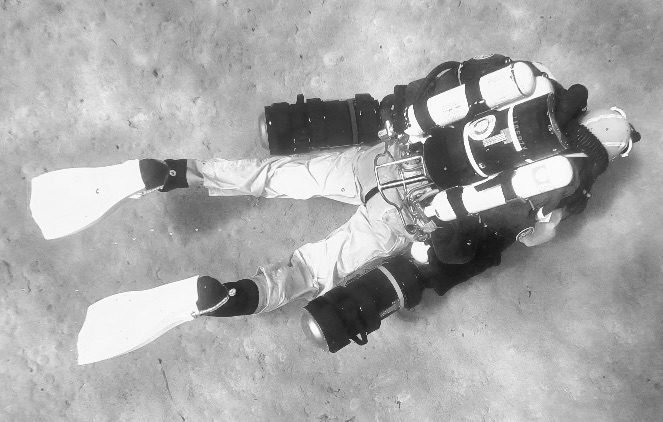
At the beginning, while messing about with building up the CCR Trilogy configuration and the endless trials and tests after each change, one problem soon became very clear. First trials are always in the pool with another observer to help with adjustments. In one of the pool trials we originally used SM diver surface valves (DSV) connected to the FFM. But the mask started drawing water. Quite pissed off, we searched for the leak source and, soon enough, I found my dumb mistake. We had a custom made mouthpiece built into the mask to access individually any of the connected rebreathers. That didn’t work out because of the DSV blow-out function. The solution was simply to get rid of the mask. Unfortunate, but I had a sexy mask replacement, and the upgrade to BOVs came along.
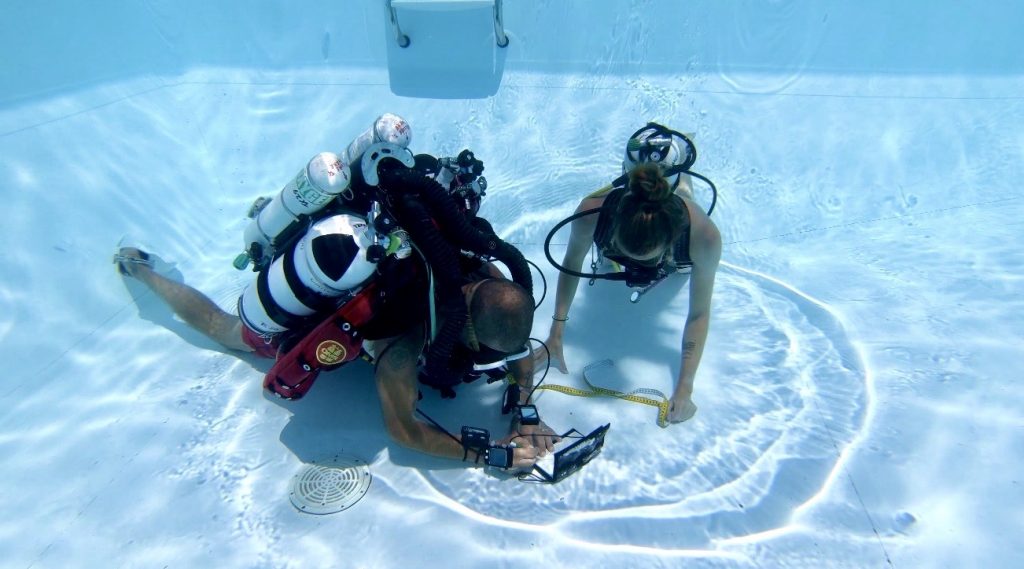
Putting The Trilogy To The Test
Sea trials commenced and the CCR trilogy concept proved its worth: During a dive test, one of the loop hoses came off a unit I was on. Total flooding and acid taste. Rebreather swapped and all was in the green. Besides the four sensors, there was no issue with the electronics of the CCR head after the flooding. Disassembling, freshwater rinse, and drying. The inner works of the Divesoft CCRs are engineered with abusers like me in mind.
While modifying the CCRs, I had to shorten the loops of the SMs which I cut to a comfortable length. When reconnecting, I didn’t tighten one of the hose connections well enough, which then got loose underwater. It’s good if you can bail out to another rebreather or two. Like on an airplane where three engines may increase your survival by a lot. The mistake was not so much that I didn’t tighten the loop connection enough, which passed the pre-dive neg/pos pressure check, but rather my failure of not paying enough “attention to detail.”
To minimize clutter, I did away with all analog pressure gauges and replaced them with eight transmitters on short hoses. Besides the pressure contents displayed on the individual handsets and the three ODAs, I also use two Shearwaters. With their ability to display four pressure contents, I programmed the respective tanks of the CCR Trilogy in sequence from left to right on screen. Put your hands together—and all eight tank pressures are visible at once. Shearwater lets you also assign a two letter/number code to the individual transmitter. That helps to identify a specific tank. If a transmitter acts up or dies, go to the next CCR.
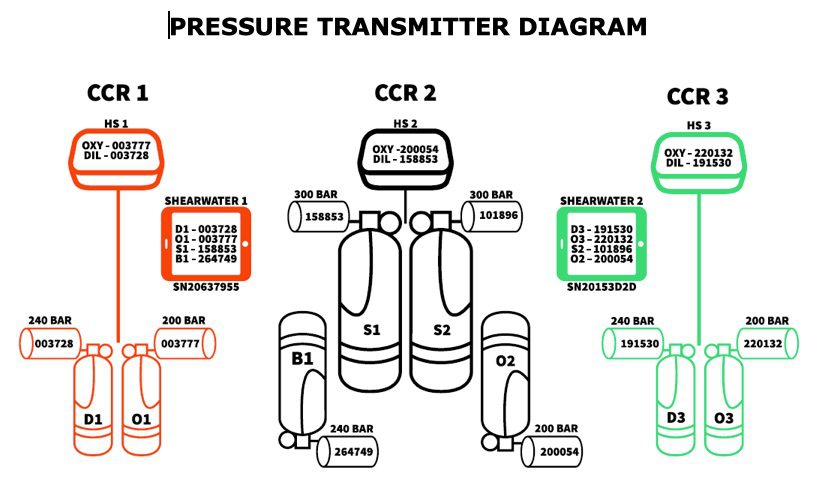
When not in use, I park the loops for the SM CCRs to the waistband at the front of the harness with forwarded D-rings next to the buckle. The BM loop stays around the neck under the chin. It is no obstruction and has no floating disturbance. All BOVs have a chin rest and are quite comfortable.
So far so good, and after lengthy trials and test dives, the CCR Trilogy is up and running. It took us about five years to reach this point. The complete CCR Trilogy system for an innerspace activity costs about 60,000 Euros. This excludes all necessary certifications to operate the units, gas, time, and other logistic costs.
Some words to a CCR Trilogy ops:
- Attitude, attention to detail, checklists, tests, back-ups, drills, and training.
- Visualization. Preparation and planning will take most of the time of a dive ops. Over the years I developed a habit of visualizing not only a dive but also its MOB and the CCR assembly. This visualization routine I keep up several days or more ahead. A side effect is to be considered unsocial.
- Buoyancy management in a blue water environment. To control vertical buoyancy during an ascent while handling the five inflating gas compartments can be a bit of a challenge. Needless to say, it is of absolute necessity to be able to easily and comfortably reach, use, and manage all the dump systems. Blind and fast. Forward thinking, preparedness (if a dump fails), and plenty of training helps not to become a rocket with five boosters. Minimizing clutter, and maintaining a clean golden triangle is of advantage.
During ascents, I found the ODA head up displays a vital help. It is similar to an airplane piloting when applying visual flight rules (VFR) vs. instrument flight rules (IFR), which are two different required licences.
At the moment, there are only a few divers who use a CCR trilogy but, with the rise of dual rebreathers, I have a feeling the CCR Trilogy club will soon expand.
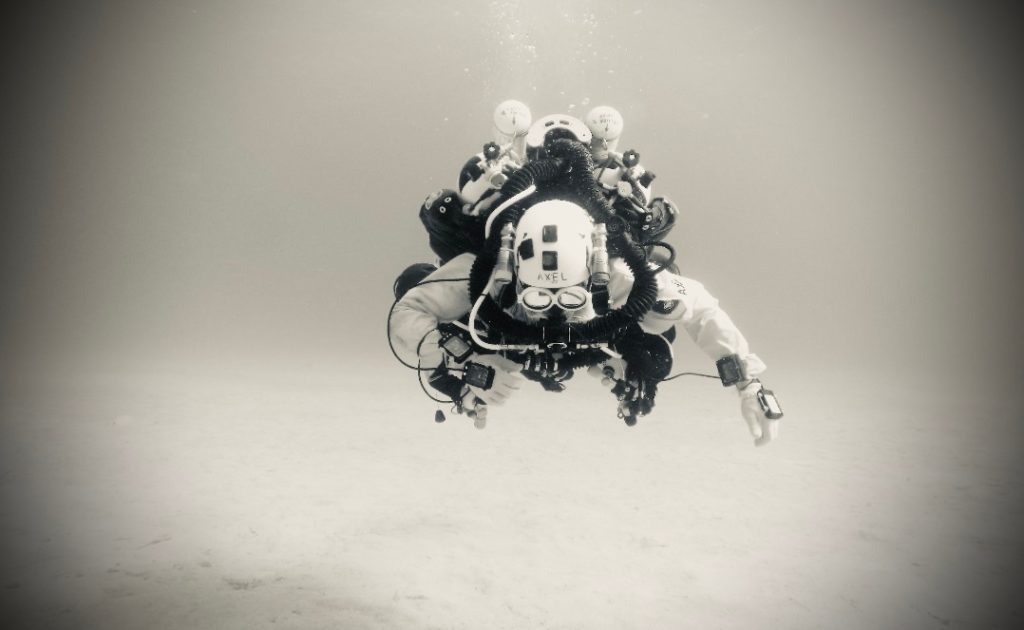
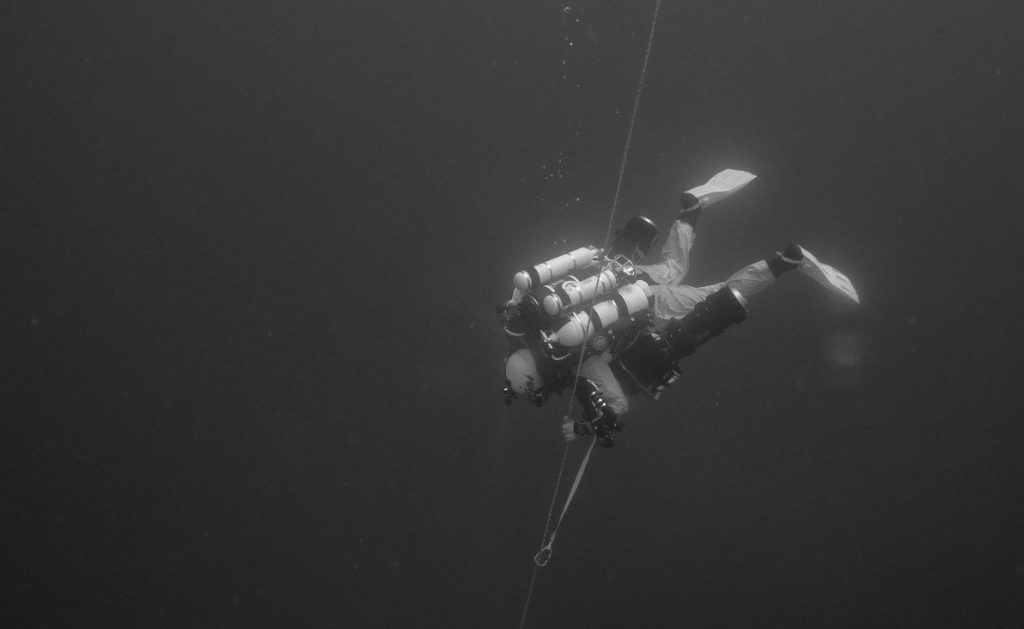

DIVE DEEPER
InDEPTH: When Easy Doesn’t Do It: Dual Rebreathers in Extended-Range Cave Diving by Tim Blomëke.

Born in Vienna, Austria, in 1963, Axel Schoeller descended from the surrounding alps to the high seas at age 15 to work in the German merchant marine as a mess-boy, and ended his sailing profession as Chief Officer at Sea Shepherd. He was first to dive the lakes and the Baltic areas in the new unified East Germany. In the USA, he joined the team of Mel Fisher and the divers of the Atocha with further similar exploits on the 1715 fleets of East Florida and up to North Carolina where he participated on the research team for DAN chamber dives, studying the effects of flying after diving. In the late 90s, he began his technical diving career in Key West, Florida, with Billy Deans, and further education with Kevin Gurr and Dave Thompson in the UK. Certification and training on several different CCR units in Europe and Asia ensued. Once back in Germany, he switched from submarine treasure hunting to marine archaeology, participating in projects in Asia, the UK, Spain, Greece, and ultimately in Cyprus followed by a career in commercial diving which allowed him to travel worldwide for construction, salvage projects and last as a commercial inspection diver in the offshore oil and gas industry. Now settled in Cyprus, he wastes his money on CCR diving in his free time, and works to advance local scientific diving.



















